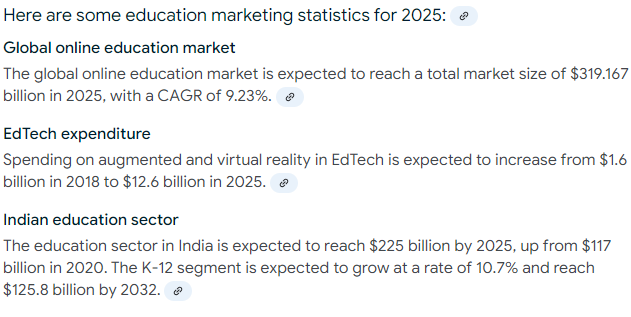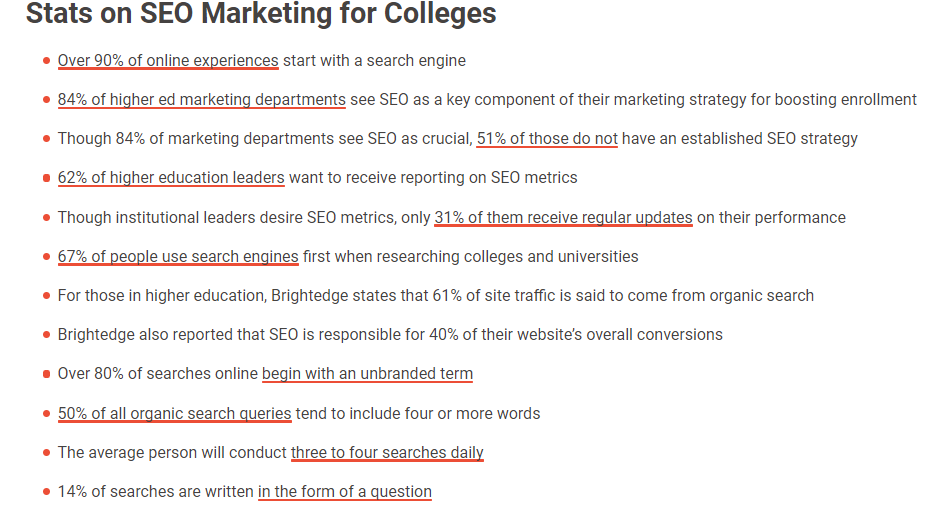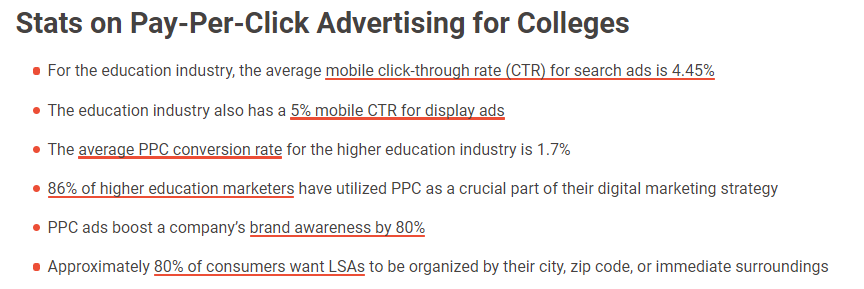In 2025, higher education digital marketing will dominate the field. According to The Chronicle of Higher Education, 85% of students now begin their college search online, using digital resources to explore options, compare programs, and engage with university representatives.

Higher education marketing has undergone significant transformations in recent years, and as we approach 2025, the landscape continues to evolve at a rapid pace.
The confluence of digitalization, changing student behaviors, and innovative marketing tools has revolutionized how institutions attract, engage, and retain students.
As an expert in higher education marketing, I’ve seen these shifts firsthand and understand the increasing importance of adapting strategies to meet the challenges and opportunities of the future.

In this guide, we’ll dive deep into the key trends, strategies, and tools that will shape higher education marketing in 2025. This article will highlight the growing significance of data-driven decision-making, personalization, and emerging technologies such as artificial intelligence (AI) and virtual reality (VR).
Whether you’re a marketing professional, an admissions officer, or a university leader, this comprehensive guide will equip you with the knowledge and insights needed to thrive in this evolving landscape.
1. The Digital Transformation of Higher Education Marketing
The digital age has drastically altered the way higher education institutions communicate with prospective students. In 2025, the transition to digital marketing will be nearly complete, with universities allocating the majority of their marketing budgets to online platforms.

The reasons behind this shift are clear: today’s students are digital natives, accustomed to accessing information online, and they expect a seamless, personalized digital experience.
1.1. The Shift from Traditional to Digital
Traditional marketing methods, such as direct mail and print advertising, have long been staples of higher education marketing. However, these methods are no longer as effective as they once were.
Today’s prospective students expect to engage with institutions through digital channels, from social media and websites to email campaigns and online content.
In 2025, higher education digital marketing will dominate the field. According to The Chronicle of Higher Education, 85% of students now begin their college search online, using digital resources to explore options, compare programs, and engage with university representatives.
1.2. The Importance of Multi-Channel Marketing
One of the key lessons learned from the digital transformation is the importance of a multi-channel marketing strategy. Students engage with institutions across various platforms, including social media, websites, mobile apps, and email.
As such, universities must adopt an integrated approach that ensures a consistent and cohesive brand presence across all these touchpoints.
Tip: To succeed in 2025, universities must build a digital ecosystem that includes personalized email campaigns, targeted social media ads, and optimized websites that cater to the student’s unique journey.
2. The Rise of Personalization in Higher Education Marketing
In 2025, personalization will become one of the most powerful tools in the higher education marketer’s toolkit. Generic, one-size-fits-all marketing messages no longer resonate with today’s students, who expect personalized interactions based on their preferences, behaviors, and interests.
2.1. Why Personalization Matters
Personalization in higher education marketing is about delivering the right message to the right student at the right time. Students are no longer passive recipients of information—they actively seek out content that is relevant to them.
A tailored experience can significantly improve engagement, drive conversions, and foster stronger relationships with prospective students.
Examples of Personalized Marketing in Higher Education:
- Tailored Email Campaigns: Sending targeted emails based on a student’s expressed interest in specific programs or extracurricular activities.
- Dynamic Web Content: Using AI to modify website content in real-time based on a visitor’s behavior, such as highlighting specific programs, application deadlines, or financial aid opportunities.
- Customized Video Marketing: Producing personalized video messages from faculty or alumni, addressing the student by name and discussing areas of study they are interested in.
2.2. AI and Data-Driven Personalization
Artificial intelligence and data analytics will play a crucial role in higher education digital marketing by enabling institutions to deliver personalized content at scale.
AI can analyze a wide range of student data points such as previous interactions, search behaviors, and demographic information to predict what content will resonate most with a particular student.
This not only enhances the student experience but also improves conversion rates by delivering highly relevant and timely content.
Key Stats:
- According to Salesforce, 78% of students say personalized communications are critical to their decision-making process.
- Institutions that implement AI-powered personalization strategies see a 30% increase in student engagement (NACAC, 2024).
3. Content is Still King: The Role of Content Marketing in 2025
While the channels and tools may change, the importance of quality content remains constant in higher education marketing. In 2025, content marketing will still be the backbone of any successful strategy, but the way institutions create and deliver content will continue to evolve.

3.1. The Evolution of Content Formats
In the past, static content such as brochures, PDFs, and web pages were the primary formats for sharing information about a university. However, students now crave dynamic and interactive content that engages them and provides value.
The focus will shift from long-form written content to more visually engaging formats like videos, infographics, and interactive tools.
Key Trends in Content Marketing:
- Video Content: Videos will continue to dominate, with student testimonials, virtual campus tours, and faculty interviews leading the charge.
- Interactive Infographics: Infographics that allow students to explore specific details about programs, campus life, or financial aid options in an engaging, visual format.
- Podcasts and Webinars: Audio content, such as student-run podcasts or faculty-led webinars, will become an increasingly popular way to showcase institutional expertise and connect with prospective students.
3.2. Storytelling: The Heart of Effective Content Marketing
Storytelling will play a more significant role in higher education marketing in 2025. Prospective students are not just looking for statistics and rankings they want to know about the community, culture, and experiences they will have at an institution.
Institutions that master the art of storytelling will stand out by creating emotional connections with their audience.
Tip: Develop authentic narratives that highlight the personal stories of current students, faculty, and alumni. Show how your institution changes lives, supports career growth, and fosters community.
4. Social Media: Engaging the Digital Native
Social media platforms continue to evolve, and in 2025, they will be an even more critical component of any higher education marketing strategy. Platforms like Instagram, TikTok, and LinkedIn offer unique opportunities for universities to engage with prospective students and build a sense of community.

4.1. The Power of User-Generated Content
User-generated content (UGC) will be a dominant force in 2025. Students trust the experiences and opinions of their peers, so encouraging current students to share their experiences through social media can be a powerful way to attract new students.
Examples of UGC Strategies:
- Student Takeovers: Allow current students to “take over” the university’s social media accounts for a day to share their campus life experiences.
- Hashtag Campaigns: Create branded hashtags that students can use to share photos and stories about their university experiences.
- Student Ambassadors: Recruit student ambassadors to create content, such as Instagram posts or TikTok videos, that highlight their unique perspectives on campus life.
4.2. Influencer Marketing for Higher Education
In 2025, higher education institutions will increasingly collaborate with influencers to reach new audiences. Influencers—especially those in the education or career space—can help universities build trust with prospective students by sharing authentic content about the value of education.
Best Practices for Influencer Marketing:
- Partner with Micro-Influencers: Collaborating with students or alumni who have a strong social media presence in niche communities can lead to more targeted and genuine engagements.
- Authenticity Over Promotion: Ensure that influencer content is authentic and aligns with the values of your institution. Audiences are quick to recognize overly promotional content, which can backfire.
5. SEO and Paid Search: Ensuring Visibility
In a crowded and competitive marketplace, it’s critical for institutions to ensure that their content is easily discoverable by prospective students.
In 2025, search engine optimization (SEO) and paid search strategies will be essential for higher education marketing success.

5.1. The Role of SEO in Higher Education Marketing
SEO remains a foundational element of any digital marketing strategy. By optimizing your institution’s website for relevant keywords and search queries, you can drive organic traffic to your site and improve visibility on search engine results pages (SERPs). However, SEO in 2025 will go beyond traditional keyword optimization.

SEO Strategies for 2025:
- Voice Search Optimization: With the rise of voice-activated search tools like Siri, Alexa, and Google Assistant, optimizing content for voice search queries will be essential.
- Local SEO: Ensure your institution appears in local search results for prospective students searching within a specific geographic region.
- Mobile-First Indexing: Google’s mobile-first indexing means that universities must prioritize mobile optimization to ensure their websites rank well on SERPs.
5.2. The Role of Paid Search
While SEO focuses on organic visibility, paid search (PPC) allows universities to target specific audiences through ads on platforms like Google Ads or Bing. In 2025, paid search will remain an important tactic for institutions looking to boost enrollment, especially for competitive programs or specific geographical areas.

Best Practices for Paid Search Campaigns:
- Targeted Keywords: Use keywords such as “higher education digital marketing,” “marketing for higher education,” and “higher education marketing strategies” to capture prospective students actively searching for universities.
- Ad Extensions: Utilize ad extensions to provide more information, such as application deadlines, campus tour availability, or direct contact options.
- Geo-Targeting: Use geo-targeting to ensure your ads reach prospective students in specific locations, such as international markets or regional areas where your institution is looking to expand its reach.
Tip: Combine SEO and PPC strategies to create a holistic approach to search visibility. While SEO takes time to build results, PPC can provide immediate visibility, allowing you to target key demographics in a timely manner.
6. The Emergence of AI and Automation in Higher Education Marketing
In 2025, artificial intelligence (AI) and automation will be pivotal in higher education marketing. These technologies allow institutions to improve the efficiency of their marketing campaigns, deliver personalized experiences at scale, and make data-driven decisions with greater precision.

6.1. AI-Powered Chatbots and Virtual Assistants
One of the most practical applications of AI in higher education marketing is the use of chatbots and virtual assistants. These tools allow institutions to provide 24/7 support to prospective students, answering questions about admissions, financial aid, or academic programs in real-time.
AI-powered chatbots can also be programmed to engage with students at various stages of the decision-making process, offering personalized content and recommendations.
Key Benefits of AI Chatbots:
- Immediate Responses: Chatbots provide instant answers to prospective students, improving their experience and keeping them engaged.
- Data Collection: Chatbots can collect valuable data on student preferences, which can be used to personalize future communications.
- Cost-Effective Support: Chatbots reduce the need for human staff to handle routine inquiries, freeing up resources for higher-level marketing and recruitment efforts.
6.2. Marketing Automation for Personalized Engagement
Marketing automation platforms allow institutions to streamline their marketing efforts by automating tasks such as email marketing, social media scheduling, and lead nurturing.
In 2025, automation will be even more advanced, with AI enabling marketers to create more sophisticated and personalized workflows that adapt to each student’s behavior.
Examples of Marketing Automation in Higher Education:
- Automated Email Campaigns: Send personalized emails to prospective students based on their interactions with your website, such as downloading a program brochure or signing up for a campus tour.
- Lead Scoring: Use automation to score leads based on their engagement levels, prioritizing high-intent students for follow-up.
- Dynamic Content Delivery: Automate the delivery of dynamic content across multiple platforms, ensuring that each student receives the right message at the right time.
Key Stats:
- Institutions using marketing automation see a 12% increase in lead conversion and a 15% reduction in marketing costs (Gartner, 2024).
7. Virtual and Augmented Reality: The Future of Immersive Experiences
In 2025, virtual reality (VR) and augmented reality (AR) will become integral components of higher education marketing, offering prospective students immersive and interactive experiences that go beyond traditional campus tours.

7.1. Virtual Campus Tours
With the rise of remote learning and international student interest, virtual campus tours will continue to grow in popularity. These tours allow prospective students to explore campus facilities, dorms, lecture halls, and social spaces from anywhere in the world, all while interacting with virtual guides or 360-degree video content.
Benefits of Virtual Campus Tours:
- Accessibility: Virtual tours make it easier for students from around the world to explore your campus without the need for travel.
- Engagement: Interactive elements, such as clickable points of interest and personalized recommendations, keep students engaged throughout the tour.
- Showcasing Facilities: Virtual tours provide an opportunity to highlight unique facilities, such as research labs, sports complexes, or innovation hubs.
7.2. Augmented Reality for Recruitment
AR technology allows institutions to bring printed materials, brochures, and posters to life by overlaying digital information on top of the physical world.
For example, prospective students could scan a university brochure with their smartphones to unlock additional content, such as videos, student testimonials, or interactive program guides.
Examples of AR in Higher Education Marketing:
- Interactive Program Brochures: Use AR to create interactive brochures that prospective students can scan to access videos, alumni stories, and course details.
- AR Lab Simulations: Allow STEM students to experience virtual lab simulations or campus activities through AR, providing a glimpse into academic life at your institution.
- Event Promotion: Use AR to promote events such as open houses, student orientations, or career fairs by embedding interactive elements into posters or invitations.
Key Stats:
- 63% of prospective students are more likely to apply to a university that offers immersive digital experiences like virtual campus tours and AR content (Statista, 2024).
8. Data-Driven Marketing: The Power of Analytics
In 2025, data will drive every aspect of higher education marketing, from decision-making to campaign optimization. Universities that leverage data effectively will be able to refine their marketing strategies, optimize their content, and improve student engagement.

8.1. The Role of Predictive Analytics
Predictive analytics uses historical data and machine learning algorithms to forecast future student behavior, such as which students are most likely to apply, enroll, or drop out.
By analyzing this data, universities can make more informed decisions about where to allocate resources, which marketing messages to prioritize, and how to engage with different student segments.
Applications of Predictive Analytics:
- Enrollment Forecasting: Predict which prospective students are most likely to enroll based on their interactions with your website, email campaigns, and social media.
- Retention Efforts: Use data to identify at-risk students early on, allowing your institution to implement interventions that improve retention rates.
- Campaign Optimization: Analyze which marketing campaigns are most effective in driving student engagement, allowing you to allocate resources more efficiently.
8.2. Real-Time Campaign Tracking
The ability to track and measure marketing performance in real-time will be essential for institutions in 2025. Real-time tracking allows universities to monitor key metrics, such as website traffic, conversion rates, and engagement levels, and make adjustments to campaigns as needed.
Tools for Real-Time Tracking:
- Google Analytics: Track website traffic, user behavior, and conversion rates across different pages and campaigns.
- HubSpot and Salesforce: Use marketing automation platforms to monitor lead generation, email open rates, and social media engagement in real-time.
- Social Media Analytics: Platforms like Facebook, Instagram, and LinkedIn provide built-in analytics tools that allow you to measure the success of your social media efforts.
Key Stats:
- 85% of institutions that use data-driven marketing report higher ROI and improved enrollment rates (Forrester, 2024).
- Real-time tracking can improve campaign effectiveness by 20%, as marketers can quickly adjust strategies based on performance (EAB Insights, 2024).
9. Sustainability and Social Responsibility in Higher Education Marketing
In 2025, sustainability and social responsibility will become even more important for higher education institutions. As Millennials and Gen Z increasingly prioritize sustainability and ethical practices, universities must align their marketing messages with these values.

9.1. The Importance of ESG (Environmental, Social, Governance)
Students today are looking for institutions that not only offer a quality education but also demonstrate a commitment to sustainability, diversity, and social impact.
Universities that actively promote their environmental, social, and governance (ESG) efforts will be more likely to attract socially-conscious students.
Sustainability-Focused Marketing Strategies:
- Highlight Green Initiatives: Showcase your institution’s sustainability efforts, such as renewable energy projects, green buildings, and carbon-neutral goals.
- Promote Social Impact Programs: Share stories about your institution’s community outreach programs, diversity initiatives, and partnerships with nonprofits.
- Transparency in ESG Goals: Be transparent about your institution’s sustainability goals and progress. Prospective students want to see real, measurable impact.
9.2. Engaging Students Through Social Responsibility
Social responsibility will not only attract students but also engage them throughout their academic journey. Institutions that foster a culture of sustainability and social impact can create strong brand loyalty among students, alumni, and staff.
Examples of Social Responsibility Campaigns:
- Sustainable Campus Tours: Highlight green spaces, energy-efficient buildings, and sustainability projects during virtual or in-person campus tours.
- Diversity and Inclusion Programs: Promote scholarships, mentorships, and student organizations that support underrepresented groups.
- Community Service Campaigns: Encourage students to participate in community service projects or sustainability initiatives, sharing their experiences on social media.
Key Stats:
- 75% of Gen Z students say that an institution’s sustainability practices influence their decision to apply (Forbes, 2024).
- Institutions that actively promote social responsibility see a 15% increase in student satisfaction and retention (EAB Insights, 2024).
Conclusion:
As we move toward 2025, the landscape of higher education marketing will continue to be shaped by digital transformation, personalization, data analytics, and emerging technologies like AI, VR, and AR.
Institutions that embrace these trends and prioritize student-centered, personalized marketing strategies will be well-positioned to thrive in an increasingly competitive environment.
The future of higher education marketing is bright, but it requires innovation, adaptability, and a deep understanding of the student journey. The institutions that succeed will be those that leverage data, deliver authentic and personalized experiences, and stay ahead of the technological curve.
The question is: Is your institution ready to meet the demands of 2025 and beyond?


Pingback: What Higher Education Marketing Will Look Like in 2025?
Pingback: Mastering School Marketing: Top 12 Content Strategies for 2025
Pingback: How 2025 Will Shape the Future of Education Policy in India
Pingback: Make Your University Stand Out as an Innovation Leader in 2025?
Pingback: Vocational Training: India’s Missing Link to Manufacturing Growth
Pingback: Power of Personalized Video Messaging in Education Marketing